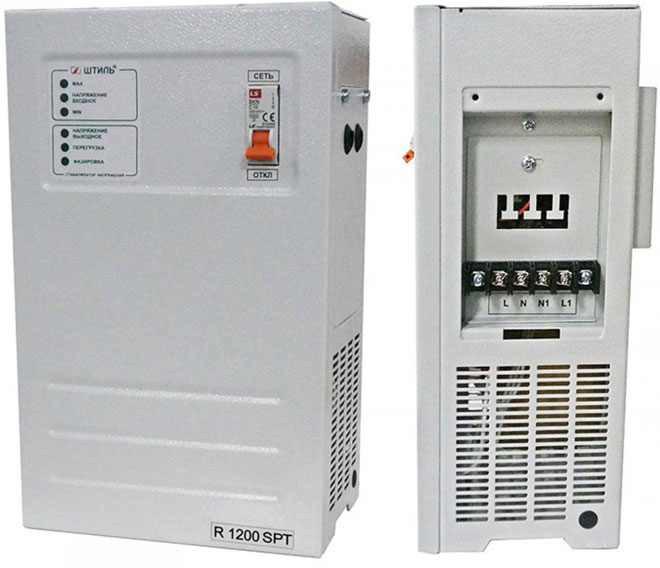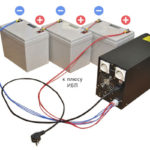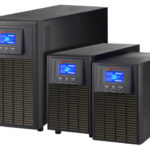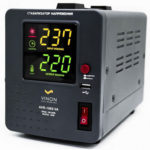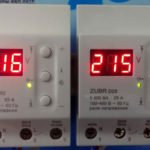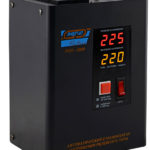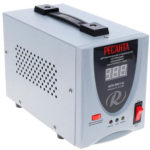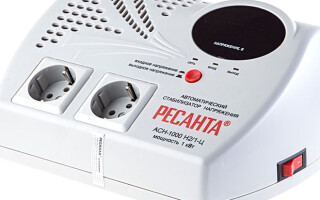Most modern heating boilers have an electronic control system that monitors compliance with the parameters and ensure safe operation. All household heating boilers, with few exceptions, are designed for power supply from a standard 230V 50Hz electrical network. Unstable operation of the power supply network and voltage fluctuations can be dangerous for the electronic "stuffing" of the device. To ensure the reliable long-term operation of the boiler and to protect it from possible problems with power supply set the voltage regulator. In this article, we will consider the question of the right choice of a stabilizer for your heating unit.
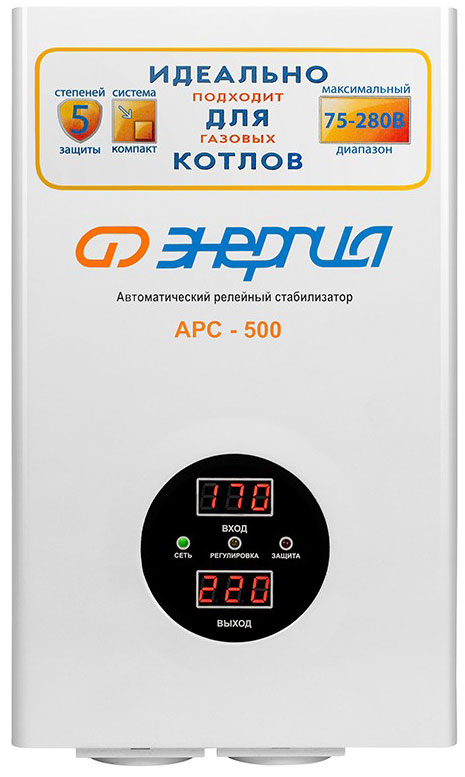
Contents
Do I need a stabilizer for the boiler?
You can often hear the opinion that the presence of a voltage regulator is not so important. "My boiler has been working fine for ten years without a stabilizer," "it normally tolerates all fluctuations," - some owners say, implying that the purchase of this device is a useless waste of money.
Indeed, modern devices can cope with small variations in voltage. Moreover, according to the interstate standard GOST 29322-2014 mains voltage is not a constant value and must be 230 V plus or minus 10%. Accordingly, the standard voltage falls within the range of 207-253 V.
However, in real life, things do not always happen according to the standards and sudden changes in the parameters of the mains are not yet a fantasy. In addition, the cause of possible problems can be many different factors, from weather conditions to human intervention. Therefore, the installation of the stabilizer still seems a justified decision and its purchase in most cases is less expensive than repairing the boiler heating in case of failure. In addition, many sellers define the installed CH as a prerequisite for the validity of the warranty.
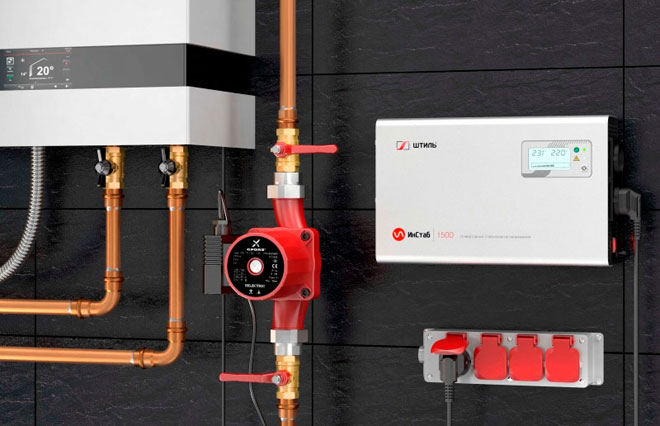
What types of stabilizers are suitable for boilers
Manufacturers produce a variety of stabilizers of different models. The devices on the market can be divided into four types:
- electromechanical (servo-driven)
- relay
- electronic (thyristor)
- Inverter .
Each type has its own characteristics, pros and cons, which should be taken into account when selecting. Here is a brief overview of equipment of each type.
Electromechanical
The principle of operation is based on circular windings of the transformer, in which the carbon brushes, controlled by the servo drive, move.
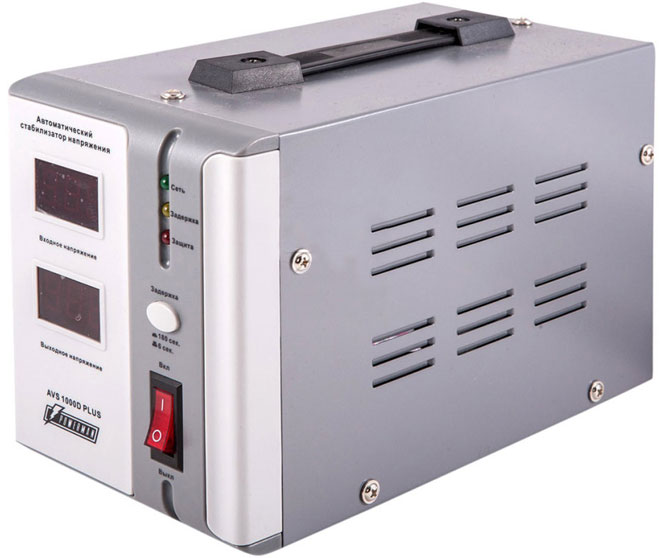
Pros: Low cost, wide input voltage range, accurate and smooth regulation, ability to tolerate overloads, ability to operate at low temperatures and high humidity, reliable overvoltage and overheating protection system, long service life.
Cons: low speed of regulation (response), increased noise level, increased weight and size compared to other types of devices.
Important! It is strictly prohibited to install electromechanical stabilizers in the premises with gas equipment! This restriction is due to the fact that during the operation of the CH of this type can form sparks. In case of a gas leak, it can lead to an explosion.
Such stabilizers can be installed for heating boilers, but it is not recommended to use them if there are frequent tangible voltage spikes. Also for safety reasons, a separate place of installation is necessary.
Relay
Widespread modern type of stabilizers. Here, the current flowing through the winding of the transformer is regulated by special relays, rather than mechanically. Some resources cite the information that the relay CHs are not suitable for heating boilers because of their low speed. Indeed, the response speed of produced earlier stabilizers of this type was low, but modern models are devoid of this disadvantage.
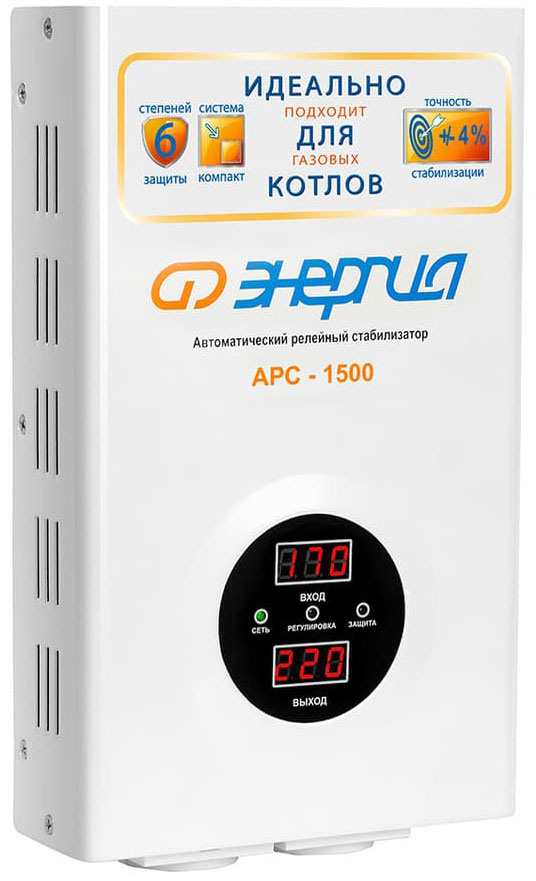
Pros: Affordable cost, wide range and high speed of regulation, reliable protection system, compact size and light weight.
Cons: step regulation, no power reserve, average noise level, short operating life.
In terms of price/quality ratio, relay stabilizers are the best choice and are widely used with heating boilers.
Electronic
Electronic stabilizers also regulate the current by passing the current through the transformer with the help of electronic keys, which allows for compact size of the device and its high efficiency.
Pros: Wide range and high speed regulation, low noise, compact size, long life.
Cons: High cost, step regulation, no power reserve.
Electronic stabilizers are more advanced and versatile solution for heating boilers. They have a higher cost than relay, so they are less common.
Inverter
Inverter stabilizers have no transformer, here the AC input current is first converted to DC, and then the necessary AC voltage is generated from it.
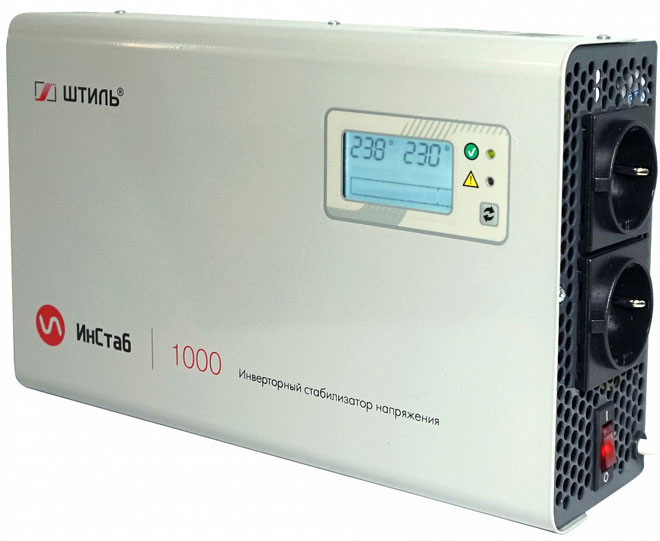
Pros: wide input range and high accuracy of output voltage, high speed and smooth regulation, no noise, minimal size and weight, long life.
Cons: high cost, lack of power reserve.
Stabilizers of this type provide the highest quality regulation, but have the highest price among the listed types.
More about the different types of voltage stabilizers for the home, written in the following article:
What characteristics of the stabilizer is necessary to consider when buying
When selecting a voltage stabilizer, it is necessary to evaluate its key characteristics and their impact on the operation of the heating boiler. This will help you to choose the model most suitable for the specific operating conditions.
Stabilizer power
One of the main parameters for choosing a stabilizer for the heating boiler - power. You can find out how much power the boiler consumes in its data sheet. It is important not to be confused, for boilers are usually specified two values: the thermal power of the boiler (usually >10 kW) and the electrical power we need (average 100-200 W or 0,1-0,2 kW).
When starting the boiler, the value may increase for a short time, the found parameter should be taken with a reserve. Also, you can not forget about the accompanying equipment, which will probably serve the stabilizer along with the boiler, it can be, for example, a circulating pump, if it is not built into the boiler itself.
In addition, if the input current decreases, the stabilizer's ability to increase it also decreases, it is also necessary to take into account the voltage drop. For example, if the socket at 170 V, instead of the put 230 V, the efficiency of the stabilizer will drop to 80% of the rated power, ie stabilizer for 500 watts should be calculated as at 400 watts.
Thus, to calculate the required power stabilizer with a reserve for starting current and drawdown at low voltage, we need to multiply the total power of the boiler and related equipment (if available) by a factor of 1.5. If the voltage in the network is very low, it is not superfluous to increase the coefficient to 1.7.
ExampleThe boiler power is 150 W, the circulation pump 100 W. Their total power (250 W) shall be multiplied by the coefficient 1.7. We obtain the minimum power of the stabilizer 425 W.
How much does the input voltage drop?
The stabilizer brings the voltage from the mains to the required 230 V. Depending on the value of the voltage drop in the network, stabilizers are available with a different range of input voltage. To find out what parameters we need a device with, it is necessary to make measurements.
To do this you will need a voltmeter (multimeter). It is desirable to make measurements at different times of the day, to see how the indicators change depending on the load on the network, while capturing the hours of maximum and minimum consumption (morning, afternoon, evening). It is better to record the data obtained, so as not to forget. It is desirable to make measurements over several days. At the end you can add to the peak values of 10-15 V each way, this will provide a small margin.
If you received values of 180-240 V, then this is the range you need a stabilizer with. In the private sector, in the countryside, the network may have more significant drops, for example, from 140 to 270 V, which should be taken into account when buying.
The output voltage of the AVR is usually standard 230 V+-10%. To avoid problems due to lack of power, it is better to choose a stabilizer with output voltage accuracy of no more than +-5%. This will ensure the parameters specified by the manufacturer and will be the key to a long trouble-free operation.
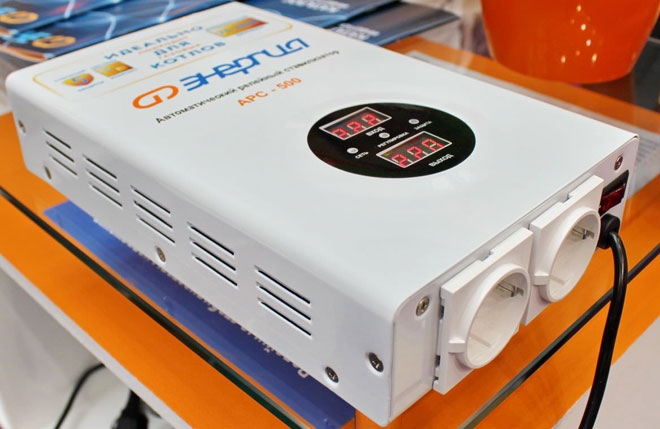
Voltage stabilization speed
This parameter consists of two characteristics:
- regulation speed - measured in volts per second (V/s), shows the stabilizer's ability to restore the standard output voltage during significant deviations of the input voltage;
- Operation time - denoted in milliseconds, indicates the time of the device reaction to a change in voltage.
The higher the speed and shorter the response time, the better the stabilizer protects your equipment. Good models have a regulation speed of 100 V/s or more. This value allows the regulator to restore the required voltage almost instantly. The rate of 15-20 V/s is not considered a good value, which can lead to short-term incorrect operation of particularly voltage-sensitive boilers.
An excellent response time is considered 5 ms or less. 10 ms will be quite acceptable, and 20 ms is satisfactory. Larger values already imply some risk.
Important! Inverter stabilizers use double conversion, as mentioned above, so they do not have the parameter of response time.
Presence of protection and restart function
Almost all modern models of stabilizers have a system of protection, which turns off the device if it is not able to ensure normal operation with a significant deviation of the network parameters or, for example, overheating.
A voltage stabilizer for the boiler must have a reset function. What does this mean? When there are strong surges or a significant drop in voltage, the device shuts down the output power, which leads to the shutdown of the boiler. The stabilizer monitors the mains parameters and when they return to an acceptable range, the power is restored, the boiler starts up and continues normal operation.
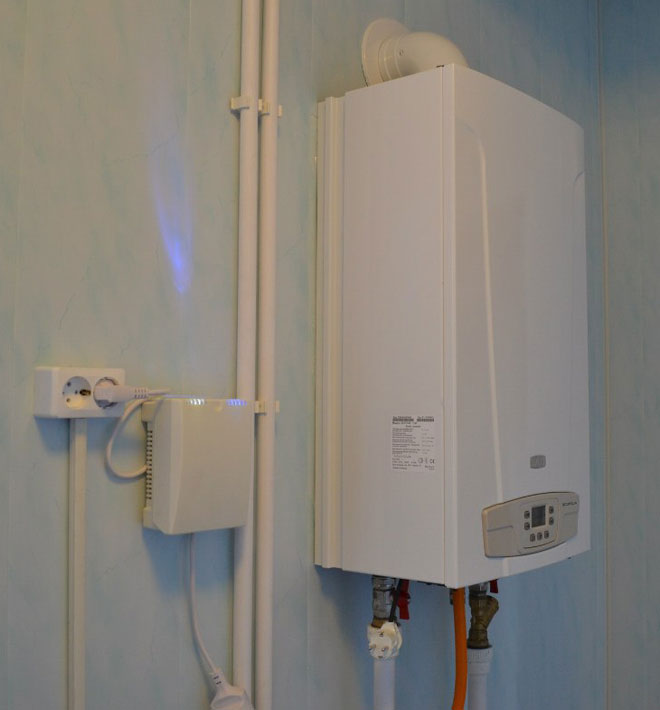
If there is no restart function, a manual restart is required to re-apply power. If the owners of the house are absent or are away in the winter time, it can cause inconvenience and even lead to serious problems (defrosting and failure of the heating system and boiler). In very cheap models, the restart function may not be, which is a bold disadvantage. Pay attention to this when buying a stabilizer.
Design
Existing devices can vary greatly in weight and size, which depends on their type. Wall and floor models, variants with digital display and pointer sensors are available. When choosing a stabilizer do not forget to plan in advance where to install it, imagine how it will look in your interior, whether you want to hide it or on the contrary, to place it in a prominent place near the boiler. Do not make the common mistake of placing the stabilizer directly under the boiler, it is forbidden by safety requirements, in case of a leak, water from the boiler can flood the electric device.
Popular brands and brands of voltage stabilizers
There is a large variety of brands and models on the market, manufactured by both Western manufacturers, and domestic companies that have long established production and, often, offer good options in terms of price/quality ratio. Popular brands on the market are Luxeon, Logic Power, Resanta, Energy, Progress, Ruself, Lider, Sven.
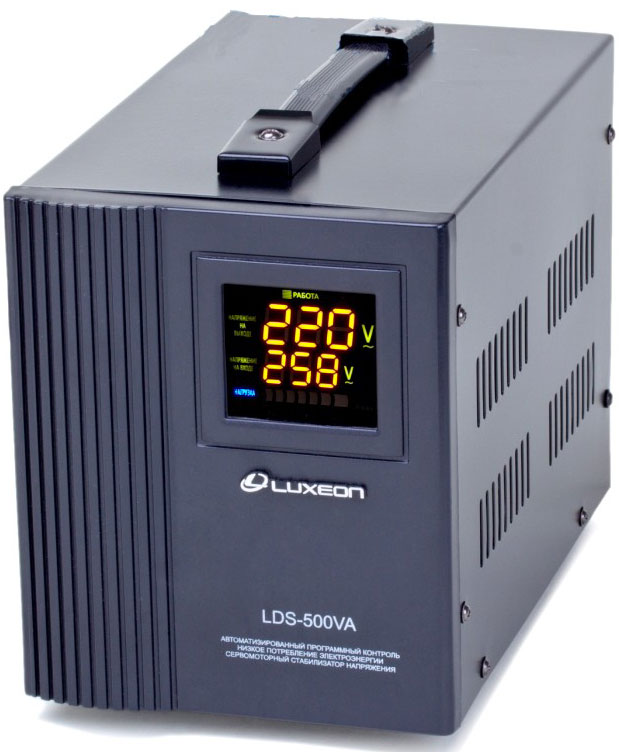
Examples of reliable boiler stabilizer models
Examples of good and reliable models of stabilizers for heating boilers by type.
Servo-driven:
- Resanta ACH1000/1-EM;
- Luxeon LDS1500 Servo;
- RUCELF SDW-1000;
- Energy CHBT-1000/1;
- Elitech ACH 1500E.

Relays:
- LogicPower LPT-1000RV;
- Luxeon LDR-1000;
- Powercom TCA-1200;
- SVEN Neo R1000;
- BASTION Teplocom ST1300.
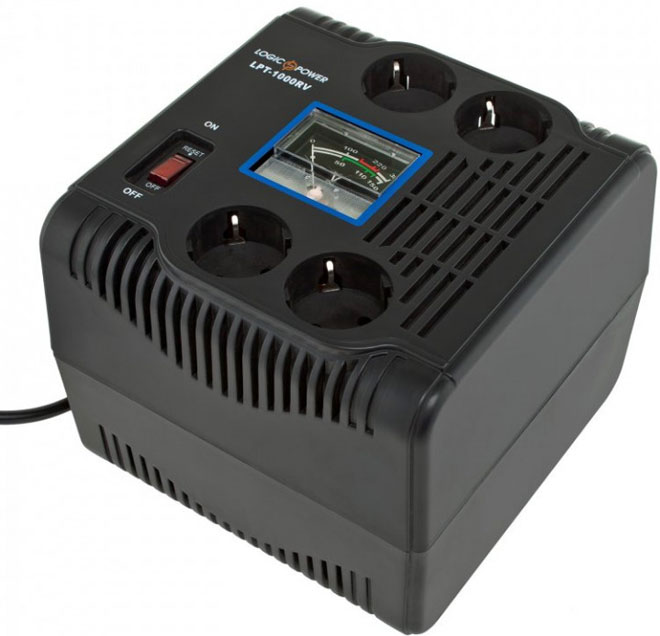
Electronic:
- Stihl R 1200SPT;
- Luxeon EDR-2000;
- Progress 1000T;
- Lider PS 1200W-30;
- Awattom SNOPT-1.0.
